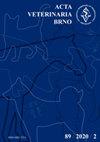The effect of conazoles on reproductive organs structure and function – a review
IF 0.7
4区 农林科学
Q3 VETERINARY SCIENCES
引用次数: 0
Abstract
Conazoles are azole antifungals used in agricultural and pharmaceutical products. Exposure to conazole fungicides leads to several toxic endpoints, including reproductive and endocrine. The results of animal experiments have shown that various conazole fungicides at high doses affect the structure and functions of reproductive organs. In males, adverse effects of conazole fungicides are manifested in the testes, prostate, sperm viability, fertility and sexual behaviour. Reduced testis weight, testis atrophy and reduced or absent sperm production were frequently observed. In female genitalia, structural changes in the ovaries and uterus have been observed. The extent of the changes depends on the dose and duration of treatment. Triazoles affected the expression of multiple genes involved in steroid hormone metabolism and modulate enzyme activity of multiple cytochrome P450 (CYP) and other metabolic enzymes in mammalian liver and other tissues. Conazole fungicides act as endocrine disruptors. Conazoles have been reported to reduce oestradiol and testosterone production and to increase progesterone concentration, indicating the inhibition of enzymes involved in the conversion of progesterone to testosterone. The reproductive effects are consistent with impairment of testosterone homeostasis. The disruption in steroid homeostasis is a common mode of action, leading to abnormal reproductive development and diminished reproductive function. At high doses, azole fungicides affect reproductive organs and fertility in several species.康唑类药物对生殖器官结构和功能的影响
康唑是一种用于农业和医药产品的抗真菌药物。接触康唑类杀菌剂会导致几种毒性终点,包括生殖和内分泌。动物实验结果表明,各种高剂量的康唑类杀菌剂对生殖器官的结构和功能有影响。在男性中,康唑杀菌剂的不良影响表现在睾丸、前列腺、精子活力、生育能力和性行为方面。睾丸重量减少,睾丸萎缩和精子产生减少或缺失是常见的。在女性生殖器中,已经观察到卵巢和子宫的结构变化。变化的程度取决于治疗的剂量和持续时间。三唑类影响哺乳动物肝脏及其他组织中多个类固醇激素代谢相关基因的表达,调节多种细胞色素P450 (CYP)及其他代谢酶的酶活性。康唑类杀菌剂具有内分泌干扰作用。据报道,康唑可以减少雌二醇和睾酮的产生,并增加孕酮的浓度,这表明它可以抑制参与将孕酮转化为睾酮的酶。生殖效应与睾酮稳态受损一致。类固醇体内平衡的破坏是一种常见的作用模式,导致生殖发育异常和生殖功能下降。在高剂量下,唑类杀菌剂会影响一些物种的生殖器官和生育能力。
本文章由计算机程序翻译,如有差异,请以英文原文为准。
求助全文
约1分钟内获得全文
求助全文
来源期刊

Acta Veterinaria Brno
农林科学-兽医学
CiteScore
1.00
自引率
33.30%
发文量
36
审稿时长
18-36 weeks
期刊介绍:
ACTA VETERINARIA BRNO is a scientific journal of the University of Veterinary and Pharmaceutical Sciences in Brno, Czech Republic.
The scientific journal Acta Veterinaria Brno is dedicated to the publication of original research findings and clinical observations in veterinary and biomedical sciences. Original scientific research articles reporting new and substantial contribution to veterinary science and original methods that have not been submitted for publication elsewhere are considered for publication. A written statement to this effect should accompany the manuscript, along with approval for publication by the author´s head of department. The authors bear full responsibility for the contents of their contribution. Book reviews are published, too.
 求助内容:
求助内容: 应助结果提醒方式:
应助结果提醒方式:


